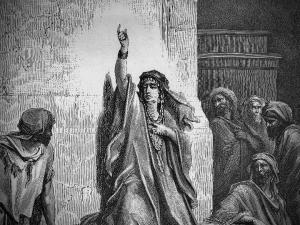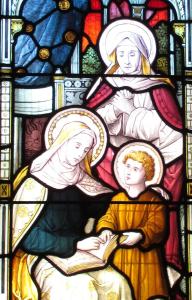
The following is Part 2 of an ongoing series exploring gender roles in the Church.
In my previous article, I shared how roughly three out of every four American churches have beliefs and policies that restrict women from taking on certain leadership roles reserved for men. Oppressive complementarianism remains so prevalent only one in every seven U.S. clergy members is a woman, and in nine out of ten Evangelical households men are the ultimate authority.
I also detailed how relying upon selective biblical views that empower men and women differently not only reflects flawed theology but also has serious psychological effects. This has been shown to lead to women feeling undervalued, low self-esteem, and chronic anxiety. Such beliefs can also hide signs of abuse and contribute to higher rates of domestic violence and sexual assault. Certainly, church-sponsored gender oppression has in some cases inspired fear of punishment creating a culture of silence masking abusive behavior.
Some churches control dissent and suppress diverse opinions through complementarian policies. This has also led to commonplace discrimination against intersex, transgender, and non-binary individuals, limiting their leadership opportunities within faith communities and marginalizing anyone who doesn’t conform to traditional gender norms.
The “Nashville Statement”
In 2017, the Ethics and Religious Liberty Commission of the Southern Baptist Convention (SBC) organized a gathering of conservative Evangelicals in Nashville. The conference addressed issues of sexuality, gender, and marriage by finding ways to recontextualize scripture and create policy standards that would challenge perceived threats to fundamentalism.

The resulting “Nashville Statement,” consisting of 14 articles, was drafted by the Council on Biblical Manhood and Womanhood (CBMW), a political lobby founded by conservative author, pastor, and self-described theologian John Piper that promotes complementarian heteronormative views.
Although the statement is the ultimate doctrinal resource for complementarianism, it’s also a manifesto petition to be signed by pastors and church leaders, a Trojan horse luring Evangelicals who favor tradition to practice discrimination and hatred.
The Nashville Statement indicates an escalation of complementarian tactics away from biblical scholarship and towards political activism. However, scripture exemplifies love and equality for all people, and it is a message Christians in America should take note of.
A Theology of Equality
The foundational narrative of creation in Genesis lays the groundwork for understanding equality between men and women.
In Genesis 1:26-27, God declares, “Let us make mankind in our image, in our likeness,” emphasizing the shared divine image in all humanity. God didn’t withhold anything. Without any established hierarchy between us, God created all humans in his image.
We were created to be equal to one another.
Interestingly, Genesis 2 describes woman as a “suitable helper” (Genesis 2:18), a term often misunderstood to mean subordinate or somehow diminished in authority, leadership, or ability. However, the Hebrew word ezer (עֵ֖זֶר) that is used is a combination of two terms, one meaning “to rescue or save” and the other “to be strong.” Of the twenty-one times this exact word is found in the Old Testament, it usually describes the actions of God as a deliverer of his people, a helper to Israel (e.g., Psalm 33:20), demonstrating a role of strength and support rather than inferiority.
Likewise, in the New Testament, the Apostle Paul‘s letter to the Galatians delivers a powerful declaration of equality in Christ:
“There is neither Jew nor Gentile, neither slave nor free, nor is there male and female, for you are all one in Christ Jesus.” (Galatians 3:28, NIV)
This verse dismantles any theological foundation for gender-based hierarchy within the body of believers. The unity proclaimed by Paul transcends societal and cultural divisions, erasing distinctions based on gender. Any attempt to impose hierarchical roles within the church contradicts the spirit of equality advanced by the gospel.
Empowered Women in the Bible

Romans 16:7 introduces Junia as “outstanding among the apostles,” a phrase that challenges complementarian views of women’s roles in church leadership. Despite efforts to downplay her apostolic status (mainly Post-Reformation, but including the inexcusably poor translation rendered by the ESV), the biblical text itself celebrates Junia’s significant contribution to the early Christian community. Junia’s acknowledgment as an apostle debunks the notion that church leadership is exclusively reserved for men.
An Old Testament example of female leadership is the account of Deborah in Judges 4–5. Deborah not only served as a judge but also functioned as a prophetess, offering guidance and wisdom to God’s people. Her leadership role challenges the notion that certain positions, especially those of authority, are inherently reserved for men. Deborah’s story invites a reevaluation of rigid gender roles within the church, underscoring the compatibility of women in leadership positions.
Acts 18:26 provides a glimpse into the collaborative ministry of Priscilla and Aquila. In this passage, Priscilla is actively involved in instructing Apollos, a man. The equality and partnership displayed in their ministry impeach interpretations that restrict women from teaching or assume a subordinate role. Recognizing Priscilla’s role as a teacher contributes to a broader understanding of shared responsibilities in Christian leadership, irrespective of gender.
Stupid Misinterpretations
Ephesians 5:22-33 is often cited to support a hierarchical view of gender roles within marriage, with an emphasis on wives submitting to their husbands. However, a closer examination reveals a call to mutual submission. Verse 21 sets the tone: “Submit to one another out of reverence for Christ.”

The subsequent verses, often quoted in isolation, are part of a larger context emphasizing mutual respect and sacrificial love between spouses. Rather than a complementarian hierarchy, the whole passage in context depicts reciprocal partnership in marriage and ministry.
Also, 1 Timothy 2:11-15 is frequently cited by complementarians to limit women’s roles in teaching and leadership within the church, and for good reasons has remained a controversial scripture for thousands of years now. However, a careful consideration of the cultural and historical context is essential.
First, because no other New Testament verse places any limitation on women whatsoever, that means:
- Either this passage is inconsistent with the Gospels and every other representation of the early church, or
- That it is addressing a specific situation at that local church.
Some of the circumstances cannot be ignored: 1 Timothy was written to a church experiencing great dysfunction. According to the letter, ministries of both women and men were quelled to spare the church from “self-destruction.”
What is most interesting to me is that such instructions are given to Timothy, who himself was taught quite capably by Lois and Eunice.
Combined with other hermeneutic and historical indications that the Ephesian women were at the very least teaching before learning or at worst forwarding non-Christian ideas, it seems obvious that the instruction was intended to be isolated and temporary.
Love is the Equalizer

Gender equality is not just a byproduct of specific verses or teachings, but an inherent truth embedded in the broader theological narrative. The essence of this lies in the acknowledgment of the shared value and dignity of both genders, a vision of humanity created in the image of a loving, relational God.
Love is the cornerstone of human and divine relationships. It’s a transformative force that breaks down barriers, transcends societal norms, and encourages mutual respect and understanding. Love guides us to navigate our relationships recognizing the qualities and potential of every individual.
This theological perspective does not focus on the authority of one gender over another but on cultivating a radical love that affirms every person. It extends an invitation to believers to embody this Christlike love in every relationship, building a community of faith where individuals are treated with dignity and respect.
How to Change and Make a Difference
Promoting gender equality in churches involves intentional steps to ensure that all members, regardless of gender, have equal opportunities, representation, and voice within the community. Here are some steps churches can take to promote equality:
Review and Revise Policies: Examine existing church policies to identify any gender biases or discriminatory practices. Work towards revising policies to ensure inclusivity, equal opportunities, and fair treatment for all genders.
Promote Women in Leadership: Actively encourage and support women to take on leadership roles within the church, including pastoral, administrative, and decision-making positions. Provide mentorship programs to help women develop leadership skills.
Inclusive Language and Imagery: Use inclusive language in worship services, sermons, and written materials to avoid reinforcing traditional gender stereotypes. Incorporate diverse imagery and stories in church communications and teachings.
Equal Opportunities for Ministry: Ensure that men and women have equal opportunities to participate in various ministries within the church, such as teaching, preaching, and outreach. Create platforms for individuals to discover and utilize their spiritual gifts, irrespective of gender.
Family-Friendly Policies: Implement family-friendly policies, such as flexible scheduling for church events, to accommodate the diverse needs of both men and women with families. Support initiatives that promote work-life balance for all members.
Address Gender-Based Violence: Develop and promote policies against gender-based violence within the church community. Provide resources and support for those affected by domestic violence or abuse.
Representation in Decision-Making: Ensure diverse gender representation in decision-making bodies and committees within the church. Actively seek input from women in the decision-making process.
Promote Gender Equality Beyond the Church: Engage in community outreach programs that address gender equality issues and contribute to positive social change. Collaborate with organizations working towards gender equality in the wider community.
Continuous Evaluation: Regularly evaluate progress and assess the effectiveness of gender equality initiatives within the church. Be open to feedback from the congregation and adjust strategies as needed.
By taking these steps, churches can contribute to creating an inclusive and equitable environment where every individual can fully participate and thrive, regardless of their gender.














